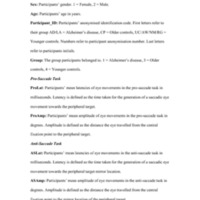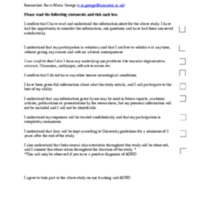Eye tracking
Dublin Core
Title
Eye tracking
Description
Understanding psychological processes though eye tracking
Items in the Eye tracking Collection
Could eye movements provide a window into early signs of dementia? Investigating the relationship between eye movements and cognitive decline.
Past research has indicated a relationship between eye movement abilities and cognitive decline. Specifically, performances on the anti-saccade task and pro-saccade task have demonstrated a correlation with Alzheimer’s disease (AD) severity,…
Experiencing social acceptance and rejection through ‘likes’ and ‘dislikes’: Does sleep quality affect the processing of social rewards?
In adolescence, high importance is placed on peer evaluations and social rewards have increased salience during this developmental period. Sleep patterns also change in adolescence, as teenagers typically experience insufficient sleep. This research…
Infants' Awareness of Number: Innate Ability or Perceptual Bias?
In order to identify the origin of our understanding of numerosity and arithmetic abilities, it is essential that such abilities are measured in infants. In Wynn’s (1992) study, a case was made for an innate ability to perform arithmetic operation…
Lights, Camera, Action: Investigating Advertisement Susceptibility in Films Amongst Individuals with Parkinson’s Disease and Controls.
Product placement is the merging of entertainment with advertising, and its presence in our daily lives is increasing. Despite this, there is an inherent lack of consideration of its influence amongst vulnerable populations such as individuals with…
Eye tracking and Attention Deficit Hyperactivity Disorder (ADHD): Can eye tracking identify the feigning of ADHD?
When diagnosing adult ADHD, it has proven difficult for clinicians to detect deceptive behaviour. Diagnosis of ADHD comes with economic, academic, and recreational benefits, which may account for the increasing feigning of the disorder. Current…
Levodopa and antisaccade performance in Parkinson’s disease: the influence of intrinsic dopaminergic functioning, dopamine agonists and chronic anti-parkinsonian medication
The antisaccade (AS) task is a validated eye-tracking paradigm primarily used to assess response inhibition. Although several studies have established AS error rate and latency to be increased in Parkinson’s disease (PD), the evidence regarding the…




